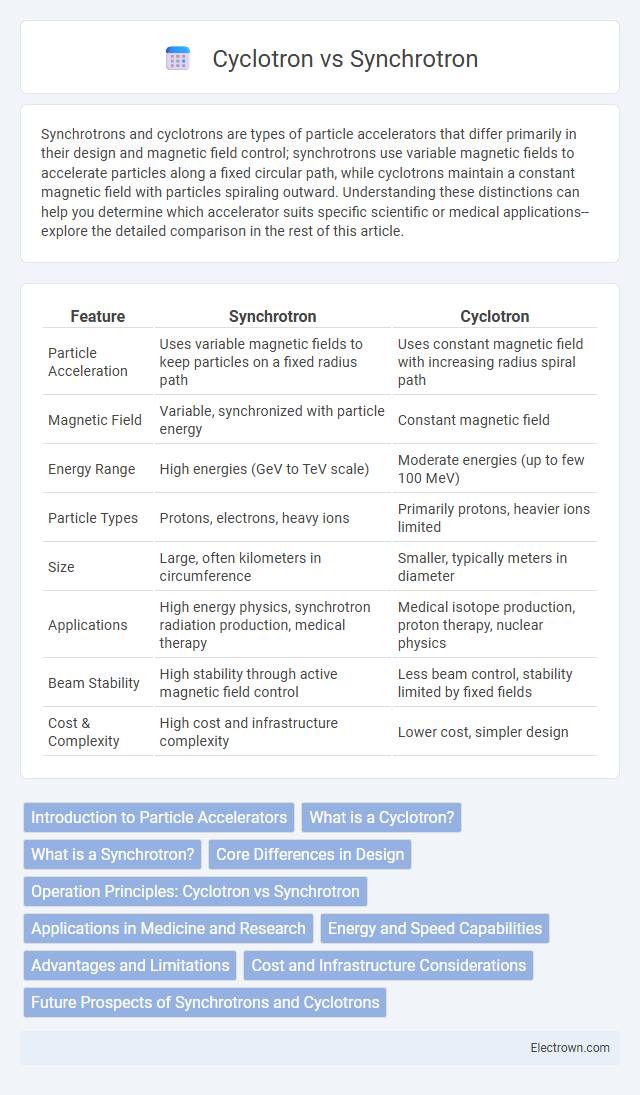Synchrotrons and cyclotrons are types of particle accelerators that differ primarily in their design and magnetic field control; synchrotrons use variable magnetic fields to accelerate particles along a fixed circular path, while cyclotrons maintain a constant magnetic field with particles spiraling outward. Understanding these distinctions can help you determine which accelerator suits specific scientific or medical applications--explore the detailed comparison in the rest of this article.
Table of Comparison
| Feature | Synchrotron | Cyclotron |
|---|---|---|
| Particle Acceleration | Uses variable magnetic fields to keep particles on a fixed radius path | Uses constant magnetic field with increasing radius spiral path |
| Magnetic Field | Variable, synchronized with particle energy | Constant magnetic field |
| Energy Range | High energies (GeV to TeV scale) | Moderate energies (up to few 100 MeV) |
| Particle Types | Protons, electrons, heavy ions | Primarily protons, heavier ions limited |
| Size | Large, often kilometers in circumference | Smaller, typically meters in diameter |
| Applications | High energy physics, synchrotron radiation production, medical therapy | Medical isotope production, proton therapy, nuclear physics |
| Beam Stability | High stability through active magnetic field control | Less beam control, stability limited by fixed fields |
| Cost & Complexity | High cost and infrastructure complexity | Lower cost, simpler design |
Introduction to Particle Accelerators
Particle accelerators like synchrotrons and cyclotrons are essential tools in high-energy physics, designed to propel charged particles to significant speeds using electromagnetic fields. Cyclotrons accelerate particles in a spiral trajectory within a constant magnetic field, making them suitable for lower energy applications. Synchrotrons, by varying magnetic field strength in synchronization with particle energy, enable acceleration to much higher energies along a fixed circular path, facilitating advanced research in fields like particle physics and materials science.
What is a Cyclotron?
A cyclotron is a type of particle accelerator that uses a high-frequency alternating voltage and a magnetic field to accelerate charged particles along a spiral path. It consists of two D-shaped electrodes called "dees" placed within a vacuum chamber, with a strong magnetic field perpendicular to the plane of the dees. Cyclotrons are widely used in nuclear physics research, medical isotope production, and radiation therapy due to their ability to produce high-energy beams of protons and other ions.
What is a Synchrotron?
A Synchrotron is a type of particle accelerator that uses magnetic fields to accelerate charged particles along a fixed circular path while synchronizing the magnetic field strength with the increasing particle energy. Unlike a Cyclotron, which has a constant magnetic field, a Synchrotron adjusts the magnetic field to maintain a stable orbital radius as particles gain velocity. Your experiments in high-energy physics or medical treatments can benefit from the precise control and higher energy levels offered by Synchrotrons.
Core Differences in Design
A synchrotron uses a fixed circular path with varying magnetic fields to accelerate particles, ensuring they remain in sync with the changing energy levels, while a cyclotron employs a constant magnetic field and a spiral path that increases radius as particles gain energy. Synchrotrons can reach higher particle energies due to their adjustable magnetic strength, whereas cyclotrons are limited by relativistic effects at high speeds. Your choice between the two depends on the desired particle energy and precision required in applications like medical therapy or particle physics research.
Operation Principles: Cyclotron vs Synchrotron
Cyclotrons accelerate charged particles using a constant magnetic field and a high-frequency alternating voltage, causing particles to spiral outward in a fixed-radius orbit. Synchrotrons vary the magnetic field strength and radiofrequency to keep particles on a fixed circular path, synchronizing acceleration with their increasing energy. This dynamic adjustment in synchrotrons allows for higher particle energies compared to the fixed-field, spiral trajectory approach of cyclotrons.
Applications in Medicine and Research
Synchrotrons produce high-intensity X-rays used in medical imaging and advanced cancer therapy, enabling precise tumor targeting with minimal damage to surrounding tissue. Cyclotrons accelerate charged particles for producing radioisotopes critical in diagnostic PET scans and radiopharmaceutical treatments. Your choice between these accelerators depends on the specific medical or research application requiring either high-resolution imaging or isotope generation.
Energy and Speed Capabilities
Synchrotrons achieve higher energy levels compared to cyclotrons by synchronizing magnetic fields with particle acceleration, enabling speeds close to the speed of light without losing synchronization. Cyclotrons are limited by relativistic effects, which cause particles to fall out of phase at higher velocities, capping their maximum energy typically in the range of tens to hundreds of MeV. Synchrotrons can accelerate particles to several GeV or higher, making them essential for cutting-edge research in high-energy physics and advanced applications.
Advantages and Limitations
Synchrotrons offer precise control over particle energy and beam focus, enabling high-energy physics experiments and medical applications like cancer radiation therapy. Cyclotrons provide continuous particle beams with simpler design and lower cost, ideal for producing medical isotopes and industrial uses. Limitations of synchrotrons include complex construction and higher operational expenses, while cyclotrons face challenges with maximum achievable energy due to relativistic effects.
Cost and Infrastructure Considerations
Synchrotrons require significant infrastructure investment due to their large size and complex magnetic systems, making their initial cost substantially higher compared to cyclotrons. Cyclotrons are more compact and have lower operational and maintenance costs, making them cost-effective for applications requiring moderate energy levels. The choice between synchrotron and cyclotron depends heavily on budget constraints and available space, with synchrotrons favored for advanced research facilities and cyclotrons preferred in clinical or industrial settings.
Future Prospects of Synchrotrons and Cyclotrons
Synchrotrons and cyclotrons both play crucial roles in particle acceleration, with synchrotrons offering greater energy flexibility and precision for future research in fields like medical therapy and materials science. Cyclotrons, valued for their compact size and cost-effectiveness, continue to improve in producing radioisotopes essential for diagnostic imaging and cancer treatments. Your choice between these technologies should consider evolving advancements, such as synchrotron upgrades for higher brightness and cyclotron innovations for increased isotope production capacity.
Synchrotron vs Cyclotron Infographic

 electrown.com
electrown.com